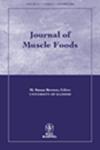A RESEARCH NOTE: EFFECT OF CITRIC ACID AND/OR ROSEMARY EXTRACT ON COLOR OF AN IRRADIATED BEEF MYOGLOBIN MODEL SYSTEM
Abstract
ABSTRACT
To determine the effect of antioxidants and irradiation on meat color, myoglobin (Mb) was extracted from beef hearts. Mb was treated with one of four antioxidants (control, citric acid [CA], rosemary extract [RE] or combination of citric acid and rosemary extract [CA/RE]) and irradiated at 0.00 (Control), 0.50, 0.75, 1.00, 1.25, 1.50, 1.75 and 2.00 kGy. Samples were then evaluated for thiobarbituric reactive substances, pH, L*, a*and b*values, hue angles, and Chroma. RE- and CA-containing samples had the highest postirradiation L*, a*and b*values, indicating they were lighter, redder and more yellow than controls. In terms of hue angles, all samples treated with antioxidants were much closer to the true red axis (a* = 0) of the CIE color space, both before and after irradiation, than was the control. The only color attribute affected by irradiation dose was L*value. Samples irradiated at 2.0 kGy were significantly lighter (L* = 5.27) than samples that had not been irradiated (L* = 1.28).
PRACTICAL APPLICATIONS
Irradiation is an effect method for extending the shelf life and improving the safety of fresh meat products; however, it can cause undesirable color changes at the surface of the meat, which appear to be the result of oxidative processes – therefore, reducing oxidation could effectively reduce color change. Studying pigment preservation is difficult in intact muscle tissue, so a myoglobin model system was developed for this purpose. Natural antioxidants were evaluated in this system. Rosemary extract and citric acid maintained color lightness and redness. Surface application of these antioxidants has the potential to preserve red meat color during irradiation.

 求助内容:
求助内容: 应助结果提醒方式:
应助结果提醒方式:


